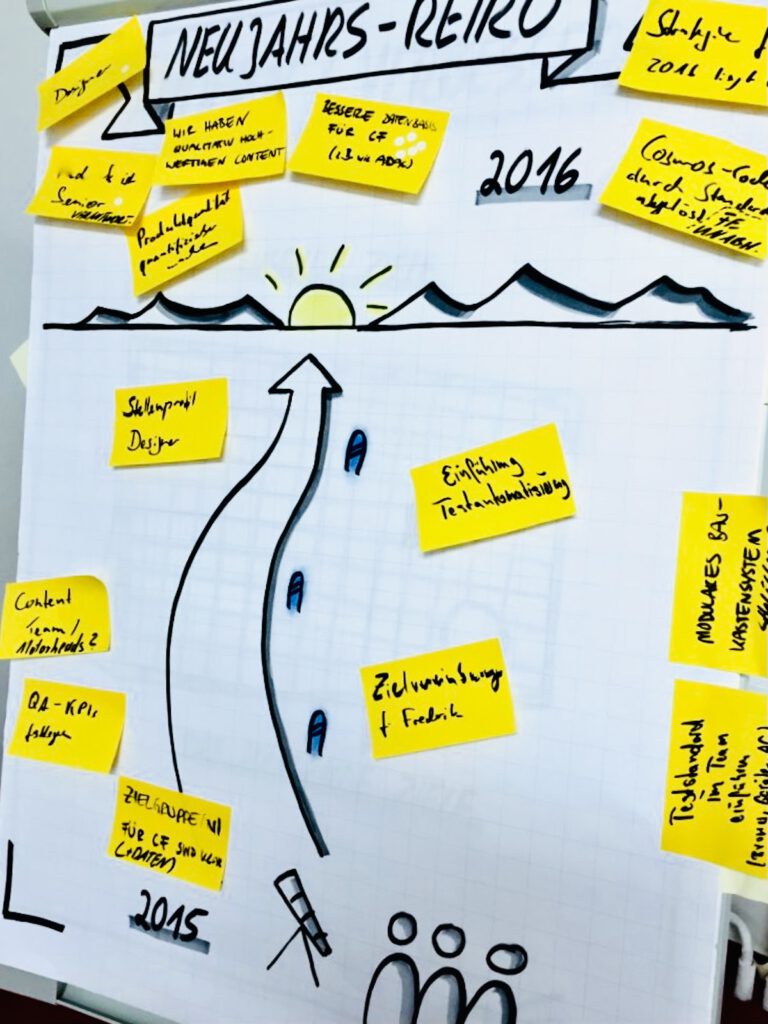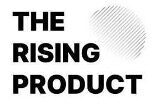TL;DR – Agile retrospectives with purpose: turning reflection into real goals
An agile retrospective can easily fall into routine. To avoid this, I propose using the New Year’s energy to take a fresh perspective. Instead of reviewing just the last sprint, he encourages teams to ask:
“Imagine it’s January next year – what would make us proud looking back?”
Key takeaways:
- Break out of short-term thinking: use agile retrospectives to define longer-term team goals.
- Focus not only on technical improvements but also on soft factors and team identity.
- Use the “Remember the Future” method to visualize success and reverse-engineer milestones.
- Help teams avoid solution-first thinking by focusing on intent and outcomes, not just tools.
- Revisit goals regularly and use simple rituals like team check-ins or visual boards to keep them alive.
Agile retrospectives aren’t just about fixing what’s broken—they’re a space to reflect on who we want to be as a team.
Agile retrospectives – What’s it all about then?
At the start of the year, I faced the initial retrospectives with my teams. Looking back over the past two weeks proved challenging due to the holidays and resulting absences. What should I do? Skip the retrospectives? That would have been the easiest solution, of course.
I recalled the annual articles in popular magazines about New Year’s resolutions. I am sceptical about personal New Year’s resolutions as they rarely work. However, in an organisation or group where people constantly interact and clear agreements are essential, it is important to set specific goals at regular intervals.
Keep the big picture in mind in agile retrospectives
Like a company as a whole, a team must also create a vision and an (internal) mission – meaning, being clear about its value to the company. Derived from this, it must define the values it operates by and what its own standards are. Only then can it derive sustainable changes.
“A team needs to know its value to the business.”
In practice, there is rarely space dedicated to such metaplanning for a team and its collaboration. Agile retrospectives typically focus on short periods, like a sprint or project. Furthermore, retrospectives are reactive (and iterative) in nature, as improvements and changes are determined based on short-term experiences.
Global and long-term goals of a team are usually not defined through this method, separate from the current sprint. These objectives may encompass the following areas:
- Team-internal KPIs, such as shorter lead times or lower error rates
- “Soft factors”, like improved communication within or outside the team
- Technical innovations and increased flexibility of the infrastructure
Remember the future
At the start, I asked the team if they agreed to switch things up in the retrospective by focusing on New Year goals rather than the last sprint. I used the Remember the Future approach and posed this question: Imagine it’s January next year. As a team, you’re content looking back on a truly successful last year. What have you achieved and what specifically made you content?
I highlighted the importance of considering all key aspects, including technical infrastructure, workflows, and communication. I divided the team into pairs and allocated ten minutes for each pair to identify their main points. To aid visualisation, I used the metaphor of a mountain hike on a flipchart.

The team members presented their objectives, and I assisted in refining, categorising, and ultimately prioritising them. It was crucial for me to question why the goals had not been achieved yet, identifying potential obstacles or missing elements.
It made me realise again how challenging it can be for teams to think on an abstract level rather than jumping straight into concrete solutions – similar to the dilemma of focusing on the WHAT versus the HOW. For instance, the idea of picking a suitable test automation tool was put forward as a project.
“Teams often struggle to avoid jumping straight into concrete solutions.”
By questioning strategically, I assisted the team in realising that a tool is not an end in itself, nor is test automation in itself, but rather can be one of many means to achieve measurably better quality and faster implementation speed.
In the next stage, I gave the pairs another ten minutes to identify the milestones necessary for achieving the goals. We also deliberated on the team’s direct impact and pinpointed a range of strategies to further enhance its autonomy. For instance, increasing individual responsibility in HR matters or enhancing platform modularisation to decrease reliance on other teams.
In the final stage, we listed the tasks that seemed achievable and realistic by the next retrospective based on the initial milestones.
Nothing is set in stone
It is crucial for the team to regularly recall the goals, ideally by visualising them in the team room and reviewing them consistently during agile retrospectives.
I recommend implementing an Operation Reviews in larger organisations, where teams present their goals, progress, and actions to each other. The aim is not to report, but to exchange ideas with other business units and address obstacles together if needed.
On the flip side, it is important to recognise that goals are […] an idea of the future or desired result that a person or a group of people envision, plan, and commit to achieve […] (Wikipedia), which means constantly assessing whether changing circumstances necessitate adjustments.
“It must be clear to everyone that goals can change due to different framework conditions.”
The method described above is most effective for teams that have been working together for an extended period. They should be able to realistically evaluate their key areas for development. All teams have had a positive experience with this type of agile retrospectives, partly due to it providing a refreshing change from the previous approach. Give it a go.
Book recommendation
Click, buy, and enrich me – my literature recommendation on the subject and an enlightening read on agile retrospectives: Agile Retrospectives, Second Edition: A Practical Guide for Catalysing Team Learning and Improvement

Hero Image: the way to hell by Erich Ferdinand

